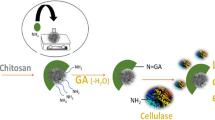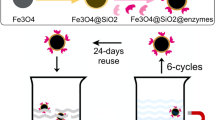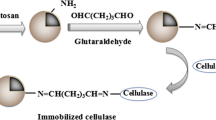Abstract
A two-step synthesis method was successfully applied to covalently immobilize cellulase Cellic CTec2 onto silicon dioxide-coated functionalized magnetic nano-Fe3O4 particle (Fe3O4@SiO2). The optimized immobilization parameters were as follows: 2% glutaraldehyde, 100 U CMCase activity of Cellic CTec2, pH 4.5, 20 °C for 4 h, holding a corresponding CMCase activity of 3341 U/g and protein loading of 50 mg/g, respectively. The morphology and composition of nanoparticles were characterized by transmission electron microscope (TEM), vibrating sample magnetometer (VSM), Fourier transform infrared (FTIR), and X-ray diffraction (XRD). The TEM images showed that Fe3O4 and Fe3O4@SiO2 particles are spherical with non-uniform size (10–20 nm) and typical core–shell shaped (20–40 nm), respectively. The VSM value of Fe3O4, Fe3O4@SiO2, and immobilized cellulase was 91 emu/g, 64 emu/g, and 59 emu/g, respectively, along with notable superparamagnetism. The FTIR and XRD spectra confirmed that cellulase has been successfully immobilized onto the amino-functionalized Fe3O4@SiO2 particles. The polyacrylamide gel electrophoresis analysis showed that there was no significant difference between free and immobilized cellulase. The immobilized cellulase showed good thermal, pH, and storage stability. In addition, the immobilized cellulase was employed for enzymatic saccharification of poplar wood, holding a maximum enzymatic saccharification rate of 38.4% at 72 h, indicating potential for lignocellulosic biomass deconstruction.






Similar content being viewed by others
References
Abbas M, Rao BP, Islam MN, Naga S, Takahashi M, Kim C (2014) Highly stable-silica encapsulating magnetite nanoparticles (Fe3O4/SiO2) synthesized using single surfactant less-polyol process. Ceram Int 40:1379–1385. https://doi.org/10.1016/j.ceramint.2013.07.019
Abbaszadeh M, Hejazi P (2019) Metal affinity immobilization of cellulase on Fe3O4 nanoparticles with copper as ligand for biocatalytic applications. Food Chem 290:47–55. https://doi.org/10.1016/j.foodchem.2019.03.117
Abraham RE, Verma ML, Barrow CJ, Puri M (2014) Suitability of magnetic nanoparticle immobilised cellulases in enhancing enzymatic saccharification of pretreated hemp biomass. Biotechnol Biofuels 7:1–12. https://doi.org/10.1186/1754-6834-7-90
Alftrén J, Hobley TJ (2014) Immobilization of cellulase mixtures on magnetic particles for hydrolysis of lignocellulose and ease of recycling. Biomass Bioenerg 65:72–78. https://doi.org/10.1016/j.biombioe.2014.03.009
Arévalo P, Isasi J, Caballero A, Marco J, Martín-Hernández F (2017) Magnetic and structural studies of Fe3O4 nanoparticles synthesized via coprecipitation and dispersed in different surfactants. Ceram Int 43:10333–10340. https://doi.org/10.1016/j.ceramint.2017.05.064
Arévalo-Cid P, Isasi J, Martín-Hernández F (2018) Comparative study of core-shell nanostructures based on amino-functionalized Fe3O4@SiO2 and CoFe2O4@SiO2 nanocomposites. J Alloys Compd 766: 609–618. https://doi.org/10.1016/j.jallcom.2018.06.246
Banu JR, Preethi KS, Tyagi VK, Gunasekaran M, Karthikeyan OP, Kumar G (2021) Lignocellulosic biomass based biorefinery: a successful platform towards circular bioeconomy. Fuel 302(15):121086. https://doi.org/10.1016/j.fuel.2021.121086
Baral NR, Sundstrom ER, Das L, Gladden J, Eudes A, Mortimer JC, Singer SW, Mukhopadhyay A, Scown CD (2019) Approaches for more efficient biological conversion of lignocellulosic feedstocks to biofuels and bioproducts. ACS Sustainable Chem Eng 7:9062–9079. https://doi.org/10.1021/acssuschemeng.9b01229
Baral P, Jain L, Kurmi AK, Kumar V, Agrawal D (2020) Augmented hydrolysis of acid pretreated sugarcane bagasse by PEG 6000 addition: a case study of Cellic CTec2 with recycling and reuse. Bioprocess Biosyst Eng 43:473–482. https://doi.org/10.1007/s00449-019-02241-3
Bilal M, Zhao Y, Rasheed T, Iqbal HM (2018) Magnetic nanoparticles as versatile carriers for enzymes immobilization: a review. Int J Biol Macromol 120:2530–2544. https://doi.org/10.1016/j.ijbiomac.2018.09.025
Bradford MM (1976) A rapid and sensitive method for the quantitation of microgram quantities of protein utilizing the principle of protein-dye binding. Anal Biochem 72:248–254
Cai C, Jin Y, Pang Y, Ke Q, Qiu W, Qiu X, Qin Y, Lou H (2018) Tracing cellulase components in hydrolyzate during the enzymatic hydrolysis of corncob residue and its analysis. Bioresour Technol Rep 4:137–144. https://doi.org/10.1016/j.biteb.2018.07.018
Chattopadhyay K, Mazumdar S (2000) Structural and conformational stability of horseradish peroxidase: effect of temperature and pH. Biochemistry 39:263–270. https://doi.org/10.1021/bi990729o
Dang F, Enomoto N, Hojo J, Enpuku K (2010) Sonochemical coating of magnetite nanoparticles with silica. Ultrason Sonochem 17:193–199. https://doi.org/10.1016/j.ultsonch.2009.05.013
Díaz-Hernández A, Gracida J, García-Almendárez BE, Regalado C, Núñez R, Amaro-Reyes A (2018) Characterization of magnetic nanoparticles coated with chitosan: a potential approach for enzyme immobilization. J Nanomater 7:1–11. https://doi.org/10.1155/2018/9468574
Donohoe BS, Resch MG (2015) Mechanisms employed by cellulase systems to gain access through the complex architecture of lignocellulosic substrates. Curr Opin Chem Biol 29:100–107. https://doi.org/10.1016/j.cbpa.2015.08.014
Du GH, Liu ZL, Xia X, Chu Q, Zhang SM (2006) Characterization and application of Fe3O4/SiO2 nanocomposites. J Sol-Gel Sci Technol 39:285–291. https://doi.org/10.1007/s10971-006-7780-5
Guo R, Zheng X, Wang Y, Yang Y, Ma Y, Zou D, Liu Y (2021) Optimization of cellulase immobilization with sodium alginate-polyethylene for enhancement of enzymatic hydrolysis of microcrystalline cellulose using response surface methodology. Appl Biochem Biotechnol 193:1–18. https://doi.org/10.1007/s12010-021-03517-9
Haven MØ, Jørgensen H (2013) Adsorption of β-glucosidases in two commercial preparations onto pretreated biomass and lignin. Biotechnol Biofuels 6:165. https://doi.org/10.1186/1754-6834-6-165
Huang W, Pan S, Li Y, Yu L, Liu R (2020) Immobilization and characterization of cellulase on hydroxy and aldehyde functionalized magnetic Fe2O3/Fe3O4 nanocomposites prepared via a novel rapid combustion process. Int J Biol Macromol 162:845–852. https://doi.org/10.1016/j.ijbiomac.2020.06.209
Jørgensen H, Pinelo M (2017) Enzyme recycling in lignocellulosic biorefineries. Biofuel Bioprod Bior 11:150–167. https://doi.org/10.1002/bbb.1724
Jung W, Sharma-Shivappa R, Park S, Kolar P (2020) Effect of cellulolytic enzyme binding on lignin isolated from alkali and acid pretreated switchgrass on enzymatic hydrolysis. 3 Biotech 10:1. https://doi.org/10.1007/s13205-019-1978-z
Kiziltaş H, Tekin T, Tekin D (2020) Synthesis, characterization of Fe3O4@SiO2@ZnO composite with a core-shell structure and evaluation of its photocatalytic activity. J Environ Chem Eng 8:23. https://doi.org/10.1016/j.jece.2020.104160
Lan T, Lou H, Zhu J (2013) Enzymatic saccharification of lignocelluloses should be conducted at elevated pH 5.2–6.2. Bioenerg Res 6:476–485. https://doi.org/10.1007/s12155-012-9273-4
Liu DM, Dong C (2020) Recent advances in nano-carrier immobilized enzymes and their applications. Process Biochem 92:464–475. https://doi.org/10.1016/j.procbio.2020.02.005
Liu W, Wang L, Jiang R (2012) Specific enzyme immobilization approaches and their application with nanomaterials. Top Catal 55:1146–1156. https://doi.org/10.1007/s11244-012-9893-0
Liu S, Yu B, Wang S, Shen Y, Cong H (2020b) Preparation, surface functionalization and application of Fe3O4 magnetic nanoparticles. Adv Colloid Interface Sci 281:102165. https://doi.org/10.1016/j.cis.2020.102165
Liu N, Chen J, Zhan P, Zhang L, Zhou X, Zeng B, Wu Z, Wang H (2020a) Optimization of mixed enzymolysis of acid-exploded poplar wood residues for directional bioconversion. BioResources 15:1945–1958. https://doi.org/10.15376/biores.15.1.1945-1958
Mao X, Guo G, Huang J, Du Z, Huang Z, Ma L, Li P, Gu L (2006) A novel method to prepare chitosan powder and its application in cellulase immobilization. J Chem Technol Biotechnol 81:189–195. https://doi.org/10.1002/jctb.1378
Mishra A, Jha B (2009) Isolation and characterization of extracellular polymeric substances from micro-algae Dunaliella salina under salt stress. Bioresour Technol 100:3382–3386. https://doi.org/10.1016/j.biortech.2009.02.006
Mubarak N, Wong J, Tan K, Sahu J, Abdullah E, Jayakumar N, Ganesan P (2014) Immobilization of cellulase enzyme on functionalized multiwall carbon nanotubes. J Mol Catal b: Enzym 107:124–131. https://doi.org/10.1016/j.molcatb.2014.06.002
Nguyen HH, Kim M (2017) An overview of techniques in enzyme immobilization. Appl Sci Converg Tech 26:157–163. https://doi.org/10.5757/ASCT.2017.26.6.157
Pan C, Hu B, Li W, Sun Y, Ye H, Zeng X (2009) Novel and efficient method for immobilization and stabilization of β-d-galactosidase by covalent attachment onto magnetic Fe3O4–chitosan nanoparticles. J Mol Catal B Enzym 61:208–215. https://doi.org/10.1016/j.molcatb.2009.07.003
Pereira C, Pereira AM, Fernandes C, Rocha M, Mendes R, Fernández-García MP, Guedes A, Tavares PB, Grenèche JM, Araújo JP (2012) Superparamagnetic MFe2O4 (M= Fe Co, Mn) nanoparticles: tuning the particle size and magnetic properties through a novel one-step coprecipitation route. Chem Mater 24:1496–1504. https://doi.org/10.1021/cm300301c
Poletto P, Pereira GN, Monteiro CRM, Pereira MAF, Bordignon SE, de Oliveira D (2020) Xylooligosaccharides: transforming the lignocellulosic biomasses into valuable 5-carbon sugar prebiotics. Process Biochem 91:352–363. https://doi.org/10.1016/j.procbio.2020.01.005
Poorakbar E, Shafiee A, Saboury AA, Rad BL, Khoshnevisan K, Ma’ mani L, Derakhshankhah H, Ganjali MR, Hosseini M (2018) Synthesis of magnetic gold mesoporous silica nanoparticles core shell for cellulase enzyme immobilization: improvement of enzymatic activity and thermal stability. Process Biochem 71:92–100. https://doi.org/10.1016/j.procbio.2018.05.012
Rai M, Ingle AP, Pandit R, Paralikar P, Biswas JK, da Silva SS (2019) Emerging role of nanobiocatalysts in hydrolysis of lignocellulosic biomass leading to sustainable bioethanol production. Cat Rev Sci Eng 61:1–26. https://doi.org/10.1080/01614940.2018.1479503
Rajnish KN, Samuel MS, John JA, Datta S, Chandrasekar N, Balaji R, Jose S, Selvarajan E (2021) Immobilization of cellulase enzymes on nano and micro-materials for breakdown of cellulose for biofuel production-a narrative review. Int J Biol Macromol182:17938–1802. https://doi.org/10.1016/j.ijbiomac.2021.05.176
Ren D, Jiang S, Fu L, Wang Z, Zhang S, Zhang X, Gong X, Chen W (2021) Laccase immobilized on amino-functionalized magnetic Fe3O4-SiO2 core-shell material for 2,4-dichlorophenol removal. Environ Technol 3:1–15. https://doi.org/10.1080/09593330.2021.1895323
Saldarriaga-Hernandez S, Velasco-Ayala C, Flores PLI, Rostro-Alanis M, Parra-Saldivar R, Iqbal MNH, Carrillo-Nieves D (2020) Biotransformation of lignocellulosic biomass into industrially relevant products with the aid of fungi-derived lignocellulolytic enzymes. Int J Biol Macromol 161:1099–1116. https://doi.org/10.1016/j.ijbiomac.2020.06.047
Sarno M, Iuliano M, Polichetti M, Ciambelli P (2017) High activity and selectivity immobilized lipase on Fe3O4 nanoparticles for banana flavour synthesis. Process Biochem 56:98–108. https://doi.org/10.1016/j.procbio.2017.02.004
Seenuvasan M, Kumar KS, Malar CG, Preethi S, Kumar MA, Balaji N (2014) Characterization, analysis, and application of fabricated Fe3O4-chitosan-pectinase nanobiocatalyst. Appl Biochem Biotechnol 172:2706–2719. https://doi.org/10.1007/s12010-014-0725-5
Shanmugam S, Krishnaswamy S, Chandrababu R, Veerabagu U, Pugazhendhi A, Mathimani T (2020) Optimal immobilization of Trichoderma asperellum laccase on polymer coated Fe3O4@SiO2 nanoparticles for enhanced biohydrogen production from delignified lignocellulosic biomass. Fuel 273:117777. https://doi.org/10.1016/j.fuel.2020.117777
Silva C, Martins M, Su J, Fu J, Cavaco-Paulo A (2018) Practical insights on enzyme stabilization. Crit Rev Biotechnol 38:335–350. https://doi.org/10.1080/07388551.2017.1355294
Singh JK, Vyas P, Dubey A, Upadhyaya CP, Kothari R, Tyagi VV, Kumar A (2018) Assessment of different pretreatment technologies for efficient bioconversion of lignocellulose to ethanol. Front Biosci 10:350–371. https://doi.org/10.2741/s521
Singh N, Dhanya BS, Verma ML (2020) Nano-immobilized biocatalysts and their potential biotechnological applications in bioenergy production. Mater Sci Energy Technol 3:808–824. https://doi.org/10.1016/j.mset.2020.09.006
Talekar S, Ghodake V, Ghotage T, Rathod P, Deshmukh P, Nadar S, Mulla M, Ladole M (2012) Novel magnetic cross-linked enzyme aggregates (magnetic CLEAs) of alpha amylase. Bioresour Technol 123:542–547. https://doi.org/10.1016/j.biortech.2012.07.044
Thangaraj B, Solomon PR (2019) Immobilization of lipases–a review. Part I: enzyme immobilization. Chembioeng Rev 6:157–166. https://doi.org/10.1002/cben.201900016
Wang H, Huang J, Wang C, Li D, Ding L, Han Y (2011) Immobilization of glucose oxidase using CoFe2O4/SiO2 nanoparticles as carrier. Appl Surf Sci 257:5739–5745. https://doi.org/10.1016/j.apsusc.2011.01.088
Xie W, Huang M (2018) Immobilization of candida rugosa lipase onto graphene oxide Fe3O4 nanocomposite: characterization and application for biodiesel production. Energy Convers Manage 159:42–53. https://doi.org/10.1016/j.enconman.2018.01.021
Xie W, Zang X (2018) Lipase immobilized on ionic liquid-functionalized magnetic silica composites as a magnetic biocatalyst for production of trans-free plastic fats. Food Chem 257:15–22. https://doi.org/10.1016/j.foodchem.2018.03.010
Zang L, Qiu J, Wu X, Zhang W, Sakai E, Wei Y (2014) Preparation of magnetic chitosan nanoparticles as support for cellulase immobilization. Ind Eng Chem Res 53:34483–43454. https://doi.org/10.1021/ie404072s
Zhang W, Qiu J, Feng H, Zang L, Sakai E (2015) Increase in stability of cellulase immobilized on functionalized magnetic nanospheres. J Magn Magn Mater 375:117–123. https://doi.org/10.1016/j.jmmm.2014.09.067
Zhao Y, Li J, Zhao L, Zhang S, Huang Y, Wu X, Wang X (2014) Synthesis of amidoxime-functionalized Fe3O4@SiO2 core–shell magnetic microspheres for highly efficient sorption of U (VI). Chem Eng J 235:275–283. https://doi.org/10.1016/j.cej.2013.09.034
Acknowledgements
This work was supported by the National Key Research and Development Program of China (2019YFB1503801) and Key Research and Development Program of Hunan Province (2020WK2019, 2019CB1002). The authors thank the help of Hunan International Joint Laboratory of Woody Biomass Conversion, Ministry of Forestry Bioethanol Research Center and Hunan Engineering Research Center for Woody Biomass Conversion.
Funding
National Key Research and Development Program of China, 2019YFB1503801, Yan Qing, Key Research and Development Program of Hunan Province, 2020WK2019, Jie-Nan Chen, 2019CB1002, Jie-Nan Chen.
Author information
Authors and Affiliations
Corresponding author
Ethics declarations
Conflict of interest
The authors declare that they have no conflict of interest.
Additional information
Publisher's Note
Springer Nature remains neutral with regard to jurisdictional claims in published maps and institutional affiliations.
Supplementary Information
Below is the link to the electronic supplementary material.
Rights and permissions
About this article
Cite this article
Huang, YY., Zhan, P., Wang, F. et al. Cellulase immobilized onto amino-functionalized magnetic Fe3O4@SiO2 nanoparticle for poplar deconstruction. Chem. Pap. 76, 5807–5817 (2022). https://doi.org/10.1007/s11696-022-02292-z
Received:
Accepted:
Published:
Issue Date:
DOI: https://doi.org/10.1007/s11696-022-02292-z




